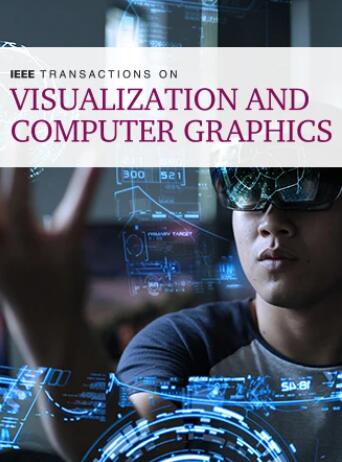Discrete Morse Sandwich: Fast Computation of Persistence Diagrams for Scalar Data - An Algorithm and A Benchmark
IF 6.5
1区 计算机科学
Q1 COMPUTER SCIENCE, SOFTWARE ENGINEERING
IEEE Transactions on Visualization and Computer Graphics
Pub Date : 2022-06-27
DOI:10.48550/arXiv.2206.13932
引用次数: 8
Abstract
This paper introduces an efficient algorithm for persistence diagram computation, given an input piecewise linear scalar field f defined on a d-dimensional simplicial complex K, with d ≤ 3. Our work revisits the seminal algorithm "PairSimplices" [31], [103] with discrete Morse theory (DMT) [34], [80], which greatly reduces the number of input simplices to consider. Further, we also extend to DMT and accelerate the stratification strategy described in "PairSimplices" [31], [103] for the fast computation of the 0th and (d-1)th diagrams, noted D0(f) and Dd-1(f). Minima-saddle persistence pairs ( D0(f)) and saddle-maximum persistence pairs ( Dd-1(f)) are efficiently computed by processing , with a Union-Find , the unstable sets of 1-saddles and the stable sets of (d-1)-saddles. We provide a detailed description of the (optional) handling of the boundary component of K when processing (d-1)-saddles. This fast pre-computation for the dimensions 0 and (d-1) enables an aggressive specialization of [4] to the 3D case, which results in a drastic reduction of the number of input simplices for the computation of D1(f), the intermediate layer of the sandwich. Finally, we document several performance improvements via shared-memory parallelism. We provide an open-source implementation of our algorithm for reproducibility purposes. We also contribute a reproducible benchmark package, which exploits three-dimensional data from a public repository and compares our algorithm to a variety of publicly available implementations. Extensive experiments indicate that our algorithm improves by two orders of magnitude the time performance of the seminal "PairSimplices" algorithm it extends. Moreover, it also improves memory footprint and time performance over a selection of 14 competing approaches, with a substantial gain over the fastest available approaches, while producing a strictly identical output. We illustrate the utility of our contributions with an application to the fast and robust extraction of persistent 1-dimensional generators on surfaces, volume data and high-dimensional point clouds.离散Morse三明治:标量数据持久图的快速计算——一种算法和基准
本文介绍了一种有效的持久图计算算法,给出了一个定义在d维单纯复形K上的输入分段线性标量场f,其中d≤3。我们的工作重新审视了具有开创性意义的算法“PairSimplices”[31],[103]和离散莫尔斯理论(DMT)[34],[80],这大大减少了需要考虑的输入简化的数量。此外,我们还扩展到DMT,并加速了“PairSimplices”[31]、[103]中描述的分层策略,用于快速计算第0个和第(d-1)个图,标注为D0(f)和Dd-1(f)。通过用并集法处理1-鞍的不稳定集和(d-1)-鞍的稳定集,有效地计算了最小-鞍持久性对(D0(f))和鞍最大持久性对。我们提供了在处理(d-1)-鞍时对K的边界分量的(可选)处理的详细描述。尺寸0和(d-1)的这种快速预计算使得[4]能够积极地专门化到3D情况,这导致用于计算D1(f)(夹层的中间层)的输入简化的数量急剧减少。最后,我们通过共享内存并行性记录了一些性能改进。我们提供了我们算法的开源实现,以实现再现性。我们还提供了一个可复制的基准测试包,该包利用公共存储库中的三维数据,并将我们的算法与各种公开可用的实现进行比较。大量实验表明,我们的算法将其扩展的开创性“PairSimplices”算法的时间性能提高了两个数量级。此外,与14种竞争方法相比,它还提高了内存占用面积和时间性能,与最快的可用方法相比有了显著的增益,同时产生了完全相同的输出。我们通过应用于快速和稳健地提取表面、体积数据和高维点云上的持久一维生成器来说明我们的贡献的效用。
本文章由计算机程序翻译,如有差异,请以英文原文为准。
求助全文
约1分钟内获得全文
求助全文
来源期刊

IEEE Transactions on Visualization and Computer Graphics
工程技术-计算机:软件工程
CiteScore
10.40
自引率
19.20%
发文量
946
审稿时长
4.5 months
期刊介绍:
TVCG is a scholarly, archival journal published monthly. Its Editorial Board strives to publish papers that present important research results and state-of-the-art seminal papers in computer graphics, visualization, and virtual reality. Specific topics include, but are not limited to: rendering technologies; geometric modeling and processing; shape analysis; graphics hardware; animation and simulation; perception, interaction and user interfaces; haptics; computational photography; high-dynamic range imaging and display; user studies and evaluation; biomedical visualization; volume visualization and graphics; visual analytics for machine learning; topology-based visualization; visual programming and software visualization; visualization in data science; virtual reality, augmented reality and mixed reality; advanced display technology, (e.g., 3D, immersive and multi-modal displays); applications of computer graphics and visualization.
 求助内容:
求助内容: 应助结果提醒方式:
应助结果提醒方式:


